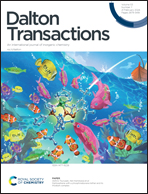Improved capacitive performances and electrocatalytic reduction activity by regulating the bonding interaction between Zn-bistriazole-pyrazine/pyridine units and diverse Anderson-type polyoxometalates†
Abstract
Electrochemical performances can be effectively improved by introducing metal–organic units (MOUs) into polyoxometalates (POMs). However, regulating the bonding strength between POMs and MOUs at the molecular level to improve the electrochemical performance is a challenging task. Three new POM-based metal–organic complexes (MOCs), namely H{Zn2(Hpytty)2(H2O)8[CrMo6(OH)6O18]}·2H2O (1), H{Zn2(Hpyttz)2(H2O)6[CrMo6(OH)6O18]}·8H2O (2), and {(μ2-OH)2Zn6(pyttz)2(H2O)10[TeMo6O24]}·2H2O (3) (H2pytty = 3-(pyrazin-2-yl)-5-(1H-1,2,4-triazol-3-yl)-1,2,4-triazolyl, H2pyttz = 3-(pyrid-2-yl)-5-(1H-1,2,4-triazol-3-yl)-1,2,4-triazolyl), were obtained. Single-crystal X-ray diffraction shows that the bonding strength (from the hydrogen bond to the coordination bond) between Zn-bistriazole-pyrazine/pyridine units and diverse Anderson-type POMs gradually increases from complexes 1 to 3. Glassy carbon electrodes modified with complex 3 (3-GCE) has the highest specific capacitance, which is 930 F g−1 at 1 A g−1. Moreover, carbon paste electrodes (1–3-CPEs) modified with complexes 1–3 are used as electrochemical sensors for detecting Cr(VI) ions, with limits of detection well below the World Health Organization (WHO) maximum level in drinking water.



 Please wait while we load your content...
Please wait while we load your content...